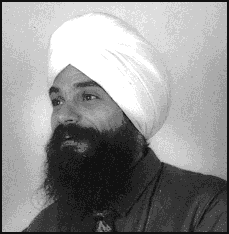Miracles
Developing Your
Capacity to Heal
Subagh Singh Khalsa
(Tuttle)

learning how to bring oneself into a state of heightened awareness and neutrality while holding an intention to heal.
He believes that some diseases evolve from inner tendencies, but by using exercises that take one into a "sensitive space," one can help oneself and others towards a path to healing. Sat Nam Rasayan has five dogmas,
- Regarding any event, all you know is what you feel;
- You do not experience an event, you feel your sensations in relation with it;
- Everything which appears in the relations is included in the relation;
- Any intention you put into the relation will effect the relation in some way.
- There is no dogma.
The process of Sat Nam Rasayan is simple. The healer will sit in the meditative position next to the healee --- I just made up that word --- who can be sitting comfortably or lying down. Both will close their eyes and relax. The healer will go into the sacred space, and at some point, he'll gently place his hand on the arm of the healee, leave it there while "being empty." After twenty or so minutes, the session is done, and the healer may communicate whatever feelings or visions he encountered during the session.
In my case, after our session, Subagh told me he saw in my pleural cavity a great dark shape, and the phrase that came to his mind was "a broken heart." And I remember thinking, "it's about time." I've been lugging this black lump-of-coal around with me for fifty years, and I had to travel 3,000 miles and wait fifty years to run into an ex-dentist who could put his finger on the Big Woe in my life.
I'm not going to lay out the whole sordid story, but let me tell you that it was in the Spring of 1954, in Philadelphia. The trees were bursting with soft buds, there were birds everywhere, and all about us was that great fecund smell of the world coming to new life. I was but twenty-one (physically) --- fifteen (emotionally) --- and the world was crammed with possibility and dreams and then I had to run into this son-of- I'd be the last to think that my Sikh nature could be maturing at this late date, but if I ever run into that bastard again, I am going to give him a piece of what's left of my mind. In any event, these beastly memories all came up with Subagh. It wasn't his fault, so I forgave him immediately. He tells me his book has been remaindered by Tuttle and maybe we should give them a piece of our mind, too. Because anyone who can write, as the author has, that "there is no distance between you and your experience," and that Consciousness has no location. It has no point of view, no place where it sits and observes the rest of the cosmos. It is everywhere... Anyone who can come up with truths like that deserves all the good we can give him.